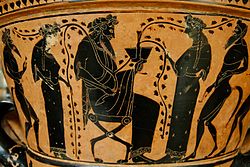
In Greek mythology[1] and religion, the thiasus (Greek: θίασος, romanized: thíasos) was the ecstatic retinue of Dionysus, often pictured as inebriated revelers. Many of the myths of Dionysus are connected with his arrival in the form of a procession. The grandest such version was his triumphant return from "India", which influenced symbolic conceptions of the Roman triumph and was narrated in rapturous detail in Nonnus's Dionysiaca. In this procession, Dionysus rides a chariot, often drawn by big cats such as tigers, leopards, or lions, or alternatively elephants or centaurs.[2][3]
The thiasos of the sea god Poseidon is depicted as a triumphal wedding procession with Amphitrite, attended by figures such as sea nymphs and hippocamps. In historical Greek society, thiasoi (pl.: Greek: θίασοι) were religious organizations whose existence was protected by law.[4]
- ^ Karl Kerenyi, Dionysos: Archetypal image of indestructible life 1976:123, observes that "the ecstatic band of bacchantes and agitated male nature gods in a state of heightened zoë ... is not reflected in Minoan art."
- ^ Cite error: The named reference
Mottowas invoked but never defined (see the help page). - ^ Cite error: The named reference
Dionwas invoked but never defined (see the help page). - ^ For example the thiasos in Athens examined by Marcus N. Tod, "A Statute of an Attic Thiasos", The Annual of the British School at Athens 13 (1906/07):328-338).